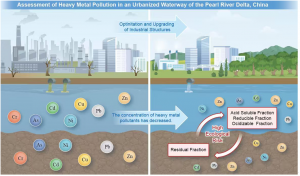Assessment of heavy metal pollution in an urbanized waterway of the Pearl River Delta, China
GA, UNITED STATES, November 7, 2025 /EINPresswire.com/ -- This study assessed industrial restructuring impacts on heavy metal pollution (Cr, Ni, Cu, Zn, As, Cd, Pb) and ecological risk in a Pearl River Delta urban waterway. Sediment concentrations followed Zn > Cr > Cu > Pb > Ni > As > Cd, all exceeding baselines, rising from 2008 to 2011 then declining through 2018, aligning with shifts to less polluting industries. Fractionation revealed Cr, Ni, and As as predominantly residual; Zn in reducible and residual; Cd acid-soluble; and Cu and Pb reducible, indicating greater human influence on Cu, Zn, Cd, and Pb. Nickel dominated water ecological risk, while Cd led in sediments. Despite adjustments, anthropogenic ecological risks persist.
The global relocation of industries driven by economic shifts has altered pollution patterns worldwide. Assessing heavy metal contamination in river sediments, which act as both sinks and potential secondary sources of pollution, provides a measure of these environmental impacts.
In a new study published in Water & Ecology, a group of researchers from China presents an assessment of heavy metal pollution and its associated ecological risks in an urbanized waterway within China's Pearl River Delta (PRD), a region undergoing economic and industrial restructuring. The research focused on seven key anthropogenically derived heavy metals—Chromium (Cr), Nickel (Ni), Copper (Cu), Zinc (Zn), Arsenic (As), Cadmium (Cd), and Lead (Pb)—in both surface water and sediment samples.
“We found that while heavy metal concentrations in water were below toxicity reference values, except for Cr, they were much higher than the global averages, with an average concentration order of Zn > Cr > Cu > Pb > Ni > As > Cd,” shares first author Benjian Mao.
A notable temporal analysis showed that concentrations of metals like Cu, Cd, and Pb increased from 2008 to 2011, but declined thereafter until 2018. This trend is consistent with the documented shift in local industrial structures, where the proportion of pollutants from secondary industries decreased after 2011, and high-pollution industries relocated.
“Source diagnostics using multivariate statistics (Pearson correlation, PCA, and CA) further supported these findings, suggesting that Cr and Ni likely originated from natural sources like rock weathering, As and Pb from anthropogenic sources such as industrial and domestic discharges, and Cu, Zn, and Cd from mixed sources,” adds Mao.
The researchers used sequential extraction to determine the geochemical fractions of these metals in sediments, which dictates their bioavailability and mobility. Cr, Ni, and As were predominantly found in the inert residual fraction, suggesting a natural origin and lower ecological risk. In contrast, Cu, Zn, Cd, and Pb were primarily associated with more mobile non-residual fractions (acid-soluble, reducible, oxidizable). Specifically, Cd was affiliated with the acid-soluble fraction, indicating high bioavailability and potential for remobilization into the water column, while Cu and Pb were mainly bound to the reducible fraction.
“The presence of Cu, Zn, Cd, and Pb was impacted more by human activities as compared to that of Cr, Ni, and As,” says Mao. “Nickel was the most dominant contributor to ecological pollution in water, while Cd contributed the most to sediment pollution.”
The ecological risk assessment provided a multi-faceted view of the contamination. In water, the Nemerow Index and Contamination Degree identified Ni as the dominant contributor to pollution. In sediments, however, Cd posed a high risk according to the Risk Assessment Code due to its high mobility, and showed heavy contamination based on the geoaccumulation Index and Contamination Factor. The overall Potential Ecological Risk Index for the sediments indicated an "extremely high" risk level, predominantly driven by Cd.
DOI
10.1016/j.wateco.2025.100016
Original Source URL
https://doi.org/10.1016/j.wateco.2025.100016
Funding information
This work was supported by the National Natural Science Foundation of Guangdong Province (No. 2015B020237006).
Lucy Wang
BioDesign Research
email us here
Legal Disclaimer:
EIN Presswire provides this news content "as is" without warranty of any kind. We do not accept any responsibility or liability for the accuracy, content, images, videos, licenses, completeness, legality, or reliability of the information contained in this article. If you have any complaints or copyright issues related to this article, kindly contact the author above.

